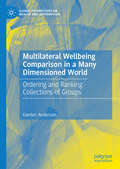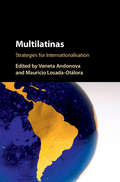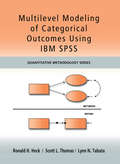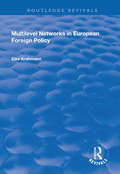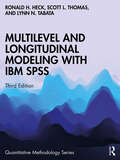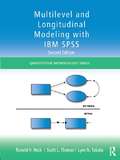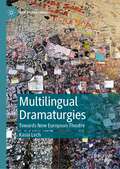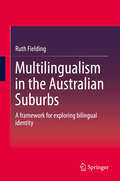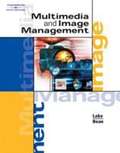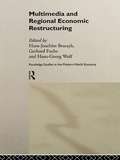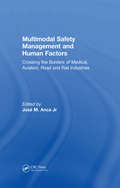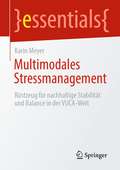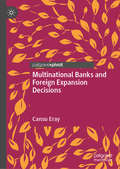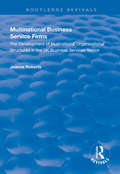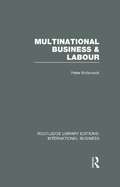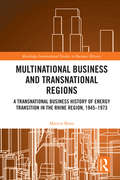- Table View
- List View
Multilateral Wellbeing Comparison in a Many Dimensioned World: Ordering and Ranking Collections of Groups (Global Perspectives on Wealth and Distribution)
by Gordon AndersonThis book addresses the disparities that arise when measuring and modeling societal behavior and progress across the social sciences. It looks at why and how different disciplines and even researchers can use the same data and yet come to different conclusions about equality of opportunity, economic and social mobility, poverty and polarization, and conflict and segregation. Because societal behavior and progress exist only in the context of other key aspects, modeling becomes exponentially more complex as more of these aspects are factored into considerations. The content of this book transcends disciplinary boundaries, providing valuable information on measuring and modeling to economists, sociologists, and political scientists who are interested in data-based analysis of pressing social issues.
Multilateralism Versus Regionalism: Trade Issues after the Uruguay Round (Routledge Research EADI Studies in Development)
by Meine Pieter Van Dijk Sandro SideriThe completion of the Uruguay Round in April 1994 has not solved all the problems. The issue of regionalism versus multilateral agreements such as the Uruguay Round remains a crucial one, as is argued in the first five chapters of this volume. Successive chapters deal with specific issues such as green protectionism, technical standards, intellectual property rights protection, the effects of disarmament on international trade, the effects of abolishing the Multi-fibre Agreement and the external impact of the European Union's Common Agricultural Policy. The volume, on the whole, takes up where the newly created World Trade Organization will have to start.
Multilateralism and Regionalism in Global Economic Governance: Trade, Investment and Finance (Routledge Studies in the Modern World Economy)
by Junji NakagawaReconciling regionalism and multilateralism is a challenge common to all branches of global economic governance. While the Bretton Woods/GATT (WTO) institutions, decades-old multilateral framework for global economic governance, are facing serious challenges to their effectiveness, regional framework are emerging as complementary or alternative means of global economic governance. The real challenge is how to reconcile multilateralism and regionalism in global economic governance. This book tackles this problem by analysing issues of multilateral/regional conciliation and coordination in global economic governance, focusing on Asia. Chapters of the book deal with challenges of multilateralism and regionalism in three fields of global economic governance, namely, global monetary/financial governance, global trade governance, and global investment governance. The major regional focus is on Asia, though some chapters deal with regionalism in Europe and North America. Topics include Asian Monetary Fund and Asian financial architecture, open accession provisions of regional trade agreements, and APEC’s role in multilateral investment rules. As a whole, the book elucidates the contemporary reach of Asian regionalism in global economic governance, and shows the neat balance between regionalism and multilateralism in global economic governance. It is of particular use to the students and practitioners of international economic law, international political economy, international finance and international economics, both with and without Asian focus.
Multilatinas: Strategies for Internationalisation
by Andonova Veneta Losada-Otálora Mauricio"The challenges faced by Latin American multinational companies, or multilatinas, often require unique strategies tailored to a demanding global environment. This book studies the strategies of internationalism exercised by large multilatinas, offering the first systematic, quantitative effort to examine the pattern of their international investments within the context of their competitive position in the domestic market. Multilatinas uncovers common strategies among sixty-two multilatinas from six countries, and emphasizes the unique challenges they face, as well as the diversity of their organizational resources. It also brings the institutional environment of Latin American countries to the fore, assessing its role as an essential component in understanding internationalization decisions. Finally, the book studies the role of non-market organizational resources such as bribes, negotiations and favours in business strategies. Multilatinas is an invaluable read for students, scholars, practitioners and executives studying Latin America's place in international business"--
Multilevel Modeling of Categorical Outcomes Using IBM SPSS: Multilevel Modeling Of Categorical Outcomes Using Ibm Spss (Quantitative Methodology Series)
by Scott Thomas Ronald H Heck Lynn TabataThis is the first workbook that introduces the multilevel approach to modeling with categorical outcomes using IBM SPSS Version 20. Readers learn how to develop, estimate, and interpret multilevel models with categorical outcomes. The authors walk readers through data management, diagnostic tools, model conceptualization, and model specification issues related to single-level and multilevel models with categorical outcomes. Screen shots clearly demonstrate techniques and navigation of the program. Modeling syntax is provided in the appendix. Examples of various types of categorical outcomes demonstrate how to set up each model and interpret the output. Extended examples illustrate the logic of model development, interpretation of output, the context of the research questions, and the steps around which the analyses are structured. Readers can replicate examples in each chapter by using the corresponding data and syntax files available at www.psypress.com/9781848729568. The book opens with a review of multilevel with categorical outcomes, followed by a chapter on IBM SPSS data management techniques to facilitate working with multilevel and longitudinal data sets. Chapters 3 and 4 detail the basics of the single-level and multilevel generalized linear model for various types of categorical outcomes. These chapters review underlying concepts to assist with trouble-shooting common programming and modeling problems. Next population-average and unit-specific longitudinal models for investigating individual or organizational developmental processes are developed. Chapter 6 focuses on single- and multilevel models using multinomial and ordinal data followed by a chapter on models for count data. The book concludes with additional trouble shooting techniques and tips for expanding on the modeling techniques introduced. Ideal as a supplement for graduate level courses and/or professional workshops on multilevel, longitudinal, latent variable modeling, multivariate statistics, and/or advanced quantitative techniques taught in psychology, business, education, health, and sociology, this practical workbook also appeals to researchers in these fields. An excellent follow up to the authors’ highly successful Multilevel and Longitudinal Modeling with IBM SPSS and Introduction to Multilevel Modeling Techniques, 2nd Edition, this book can also be used with any multilevel and/or longitudinal book or as a stand-alone text introducing multilevel modeling with categorical outcomes.
Multilevel Networks in European Foreign Policy (Routledge Revivals Ser.)
by Elke KrahmannThis title was first published in 2003. Combining a critique of existing multilevel approaches with the development of a new theory and a broad range of case studies, the author of this text aims to provide new insights into contemporary foreign policy decision-making which should be of particular interest to students and scholars of European foreign and security policy and international relations theory.
Multilevel and Longitudinal Modeling with IBM SPSS (Quantitative Methodology Series)
by Ronald H. Heck Scott L. Thomas Lynn N. TabataMultilevel and Longitudinal Modeling with IBM SPSS, Third Edition, demonstrates how to use the multilevel and longitudinal modeling techniques available in IBM SPSS Versions 25-27. Annotated screenshots with all relevant output provide readers with a step-by-step understanding of each technique as they are shown how to navigate the program. Throughout, diagnostic tools, data management issues, and related graphics are introduced. SPSS commands show the flow of the menu structure and how to facilitate model building, while annotated syntax is also available for those who prefer this approach. Extended examples illustrating the logic of model development and evaluation are included throughout the book, demonstrating the context and rationale of the research questions and the steps around which the analyses are structured. The book opens with the conceptual and methodological issues associated with multilevel and longitudinal modeling, followed by a discussion of SPSS data management techniques that facilitate working with multilevel, longitudinal, or cross-classified data sets. The next few chapters introduce the basics of multilevel modeling, developing a multilevel model, extensions of the basic two-level model (e.g., three-level models, models for binary and ordinal outcomes), and troubleshooting techniques for everyday-use programming and modeling problems along with potential solutions. Models for investigating individual and organizational change are next developed, followed by models with multivariate outcomes and, finally, models with cross-classified and multiple membership data structures. The book concludes with thoughts about ways to expand on the various multilevel and longitudinal modeling techniques introduced and issues (e.g., missing data, sample weights) to keep in mind in conducting multilevel analyses. Key features of the third edition: Thoroughly updated throughout to reflect IBM SPSS Versions 26-27. Introduction to fixed-effects regression for examining change over time where random-effects modeling may not be an optimal choice. Additional treatment of key topics specifically aligned with multilevel modeling (e.g., models with binary and ordinal outcomes). Expanded coverage of models with cross-classified and multiple membership data structures. Added discussion on model checking for improvement (e.g., examining residuals, locating outliers). Further discussion of alternatives for dealing with missing data and the use of sample weights within multilevel data structures. Supported by online data sets, the book's practical approach makes it an essential text for graduate-level courses on multilevel, longitudinal, latent variable modeling, multivariate statistics, or advanced quantitative techniques taught in departments of business, education, health, psychology, and sociology. The book will also prove appealing to researchers in these fields. The book is designed to provide an excellent supplement to Heck and Thomas's An Introduction to Multilevel Modeling Techniques, Fourth Edition; however, it can also be used with any multilevel or longitudinal modeling book or as a stand-alone text.
Multilevel and Longitudinal Modeling with IBM SPSS: Multilevel And Longitudinal Modeling With Ibm Spss (Quantitative Methodology Series)
by Ronald H. Heck Scott L. Thomas Lynn N. TabataThis book demonstrates how to use multilevel and longitudinal modeling techniques available in the IBM SPSS mixed-effects program (MIXED). Annotated screen shots provide readers with a step-by-step understanding of each technique and navigating the program. Readers learn how to set up, run, and interpret a variety of models. Diagnostic tools, data management issues, and related graphics are introduced throughout. Annotated syntax is also available for those who prefer this approach. Extended examples illustrate the logic of model development to show readers the rationale of the research questions and the steps around which the analyses are structured. The data used in the text and syntax examples are available at www.routledge.com/9780415817110. Highlights of the new edition include: Updated throughout to reflect IBM SPSS Version 21. Further coverage of growth trajectories, coding time-related variables, covariance structures, individual change and longitudinal experimental designs (Ch.5). Extended discussion of other types of research designs for examining change (e.g., regression discontinuity, quasi-experimental) over time (Ch.6). New examples specifying multiple latent constructs and parallel growth processes (Ch. 7). Discussion of alternatives for dealing with missing data and the use of sample weights within multilevel data structures (Ch.1). The book opens with the conceptual and methodological issues associated with multilevel and longitudinal modeling, followed by a discussion of SPSS data management techniques which facilitate working with multilevel, longitudinal, and cross-classified data sets. Chapters 3 and 4 introduce the basics of multilevel modeling: developing a multilevel model, interpreting output, and trouble-shooting common programming and modeling problems. Models for investigating individual and organizational change are presented in chapters 5 and 6, followed by models with multivariate outcomes in chapter 7. Chapter 8 provides an illustration of multilevel models with cross-classified data structures. The book concludes with ways to expand on the various multilevel and longitudinal modeling techniques and issues when conducting multilevel analyses. Ideal as a supplementary text for graduate courses on multilevel and longitudinal modeling, multivariate statistics, and research design taught in education, psychology, business, and sociology, this book’s practical approach also appeals to researchers in these fields. The book provides an excellent supplement to Heck & Thomas’s An Introduction to Multilevel Modeling Techniques, 2nd Edition; however, it can also be used with any multilevel and/or longitudinal modeling book or as a stand-alone text.
Multilingual Dramaturgies: Towards New European Theatre (New Dramaturgies)
by Kasia LechMultilingual Dramaturgies provides a study of dramaturgical practices in contemporary multilingual theatre in Europe. Featuring interviews with international theatremakers, the book gives an insight into diverse approaches towards multilingual theatre and its dramaturgy that reflect cultural, political, and economic landscapes of contemporary Europe, its inhabitants, and its theatres. First-hand accounts are contextualized to reveal a complex set of negotiations involved in the creative and political tasks of staging multilingualism and engaging the audience, as well as in practical issues like funding and developing working models. Using interviews with practitioners from a diverse range of theatrical backgrounds and career levels, and with various models of financial support, Multilingual Dramaturgies also offers an insight into different attitudes towards multilingualism in European theatres. The book illuminates not only the potential for multilingual dramaturgies, but also the practical and creative difficulties involved in making them. By bringing the voices of artists together and providing a critical commentary, the book reveals multilingual dramaturgies as webbed practices of differences that also offer new ways of understanding and performing identity in a European context. Multilingual Dramaturgies sheds light on an exciting theatre practice, argues for its central role in Europe and highlights potential directions for its further development.
Multilingualism in the Australian Suburbs
by Ruth FieldingThis book introduces a framework for examining bilingual identity and presents the cases of seven individual children from a study of young students' bilingual identities in an Australian primary school. The new Bilingual Identity Negotiation Framework brings together three elements that influence bilingual identity development - sociocultural connection, investment and interaction. The cases comprise individual stories about seven young, bilingual students and are complemented by some more general investigations of bilingual identity from a whole class of students at the school. The framework is explained and supported using the students' stories and offers readers a new concept for examining and thinking about bilingual identity. This book builds upon past and current theories of identity and bilingualism and expands on these to identify three interlinking elements within bilingual identity. The book highlights the need for greater dialogue between different sectors of research and education relating to languages and bilingualism. It adds to the increasing call for collaborative work from the different fields interested in language learning and teaching such as TESOL, bilingualism, and language education. Through the development of the framework and the students' stories in this study, this book shows how multilingual children in one school in Australia developed their identities in association with their home and school languages. This provides readers with a model for examining bilingual identity in their own contexts, or a theoretical construct to consider in their thinking on bilingualism, language and identity.
Multimedia Reporting: How Digital Tools Can Improve Journalism Storytelling (Tsinghua Global Business Journalism Series)
by Richard Scott DunhamThis is the first book to apply multimedia tools to economic and business storytelling. By examining the journalism essentials as well as the advanced multimedia skills, it helps readers use the latest technological tools to integrate multimedia elements into traditional news coverage. It also explains how to tell stories solely through multimedia elements. The new language of online journalism includes writing for digital platforms, writing blogs and writing for social media and involves a wide range of multimedia skills, like video, audio, photography, graphics, data visualization and animation. Multimedia journalism allows a two-way communication with the audience that was not possible in traditional “legacy” media, and this textbook is replete with links to useful tutorials, examples of award-winning multimedia stories, and advanced digital resources, offering journalists a road map to the brave new world of digital reporting and editing.
Multimedia and Image Management
by Karen Bean Susan LakeMultimedia and Image Management prepares students for a business world in which they will be expected to use business-standard software applications and to complete projects and solve problems. The applications include word processing, presentation, digital photography, image manipulation, animation, and speech recognition. This text teaches students the more creative end of business technology.
Multimedia and Image Management: Activities
by Karen Bean Susan E. L. LakeMost of the applications discussed within this book are available for both the Windows and Macintosh operating systems, and the activities described can be worked easily on either system.
Multimedia and Regional Economic Restructuring (Routledge Studies in the Modern World Economy #No.21)
by Gerhard Fuchs Hans-Joachim Braczyk Hans-Georg WolfSince the explosion of multimedia, the creation and promotion of multimedia clusters has become a target for regional development strategies across the globe. This work offers the first inter-regional comparison of the multimedia industry. Analysing thirteen American, European and Asian regions, leading academics examine factors which drive the emergence of multimedia clusters and processes by which they are formed,
Multimedia: A Critical Introduction
by Richard WiseMultimedia: A Critical Introduction is a comprehensive guide to the new media form which has resulted from the application of computer technology to existing techniques of broadcasting and telecommunications transmission. The rapid growth of multimedia technologies such as the internet, e-mail and digital television holds the promise of a new 'information age' in which individual tastes are catered for, citizens become better informed, and new wealth is created. But are new media technologies really designed to achieve these utopian aims?Multimedia: a critical introduction provides a historical, cultural and political context to the development of multimedia, as both a technology and a concept. Individual chapters address:* the origins of multimedia in the unlikely interaction between the military and 1960s counter-culture: how the phenomenal US budgets allocated to US military research resulted in the microchip, and why the efforts of counter-culture computer hobbyists evolved into a multi-billion dollar industry.*the wider democratic and cultural implications of multimedia in the wake of the deregulation of the media industries by 'new right' governments in the 1980s, which has led to the domination of the media by transnational conglomerates.* issues of privacy and censorship in relation to new media, including discussion of cryptography, electronic surveillance, and attempts to regulate material such as pornography on the internet.* the use of digital technology to create special effects in feature films.
Multimethod Research, Causal Mechanisms, and Case Studies: An Integrated Approach
by Gary GoertzAn innovative and accessible textbook on multimethod and case-study researchMultimethod research has become indispensable to doing social science, and is essential to anyone who conducts large-scale research projects in political science, sociology, education, comparative law, or business. This authoritative and accessible book offers the first truly comprehensive approach to multimethod and case-study research, and is particularly aimed at students of qualitative methods in the social sciences.Walking step-by-step through these cutting-edge tools and techniques, Gary Goertz introduces a new integrated approach that unites three corners of a powerful research triad—causal mechanisms, cross-case causal inference, and within-case causal inference. He explains how the investigation of causal mechanisms and the making of within-case causal inference are the central goals of multimethod and case study research, and provides a logic for connecting case studies and causal mechanism analysis with cross-case analysis, whether they are statistical analyses, experiments, or QCA. In addition, Goertz analyzes how one can generalize using case studies, as well as systematically test game-theoretic and other models using multiple case studies.Provides a fully integrated approach to multimethod and case-study researchAn essential resource for students and researchers in political science, sociology, education, law, and businessCovers constraint causal mechanism, game theory and case studies, QCA, and the use of case studies to systematically test and generalize theoriesAn ideal textbook for a first-year graduate course in methods or research design
Multimodal Safety Management and Human Factors: Crossing the Borders of Medical, Aviation, Road and Rail Industries
by José M. JrSafety management and human factors disciplines are often regarded as subjective and nebulous. This perhaps stems from a variety of, sometimes disparate, activities in the realms of education, industry and research. Aviation is one of the safety-critical industries that has led the development of safety systems and human factors. However, in recent years, safety management and human factors are seen to be progressing well in the road, rail and the medical arena. Multimodal Safety Management and Human Factors is a wide-ranging compendium of contemporary approaches in the aviation, road, rail and medical domains. It brings together 28 chapters from both the academic and professional worlds that focus on applications, tools and strategies in safety management and human factors. It is a wellspring of the practical rather than the theoretical. Safety scientists, human factors industry practitioners, change management advocates, educators and students will find this book extremely relevant and challenging.
Multimodal Transport Law
by Michiel SpanjaartAn accessible introduction to multimodal contracts of carriage, Multimodal Transport Law works from general principles toward specific, technical problems. Adopting an international approach, it addresses such key topics as: Contracts of carriage Transport documents The parties to a contract of carriage International conventions on the carriage of goods Multimodal situations covered by unimodal conventions Conflict of laws The rules applicable to the individual legs of multimodal contracts of carriage The Rotterdam Rules Providing a close examination of the relevant rules, regulations and case law, this is essential reading for law students, useful for claims handlers and practitioners, and of interest for academics and legislators seeking a better appreciation of multimodal contracts of carriage.
Multimodales Stressmanagement: Rüstzeug für nachhaltige Stabilität und Balance in der VUCA-Welt (essentials)
by Karin MeyerDie VUCA-Welt präsentiert sich als komplex, mehrdeutig, unsicher und volatil. In diesem Umfeld der Arbeit 4.0 sind Kenntnisse der eigenen Stärken und Schwächen gefragt – ebenso Kompetenzen zur Stressbewältigung. Dieser Essential gibt wesentliche Einblicke in die Relevanz und Grundlagen des multimodalen Stressmanagements in dynamischen Zeiten, in denen es auch gilt, für Zusatzbelastungen beispielsweise im Rahmen einer Pandemie gerüstet zu sein. Es werden Handlungsempfehlungen im Überblick abgebildet – mit dem Ziel, Impulse und Anregungen für die Praxis zu bieten und zur Selbstreflexion anzuleiten.
Multinational Accounting: Segment Disclosure and Risk (Routledge Library Editions: Accounting)
by Bimal ProdhanUp until the mid 1980s multinational enterprises usually published only consolidated worldwide accounts. This changed in subsequent years with increasing legal requirements to publish separate national accounts for each subsidiary. Obviously this exposes the subsidiary to the risk of takeover by a competitor and/or to intervention on the part of the host government. This book presents an authoritative and in-depth analysis of the disclosure issue from both theoretical and practical standpoints. The author describes the methods used to research and evaluate disclosure risks and benefits and presents much new thinking and many new research findings on this important topic.
Multinational Banks and Foreign Expansion Decisions
by Cansu ErayThis book presents a systematic review of the literature on the foreign expansion decisions of multinational banks (MNBs). With today's increasing level of globalization, many banks have expanded their activities internationally to take advantage of new opportunities in different markets. As each extension strategy brings distinctive benefits and challenges, finding an optimal approach to internationalization plays a crucial role in maximizing the advantages while decreasing the drawbacks under changing conditions. After screening 141 papers, 28 articles from leading international research journals were selected according to defined criteria in order to provide a synthesized framework connecting MNBs’ decisions to enter foreign markets with the reasons and consequences.The book argues that the MNBs’ main motivations for foreign expansion are related to location and ownership factors. Based on the priorities of these motives, MNBs can choose cross-border lending, greenfield investment or acquisition as an entry mode. Since each has its own benefits and challenges, the chosen strategy has further implications for both the profitability of MNBs and the economic conditions of the host country regarding the competition level, lending pattern to small and medium enterprises (SMEs), market interest rates and financial stability.After establishing a link between the main drivers of foreign expansion, the entry mode choices, and the impacts of foreign bank presence in the host country, the book offers managers of MNBs insights into the further implications. Highlighting the gaps in literature, it also appeals to researchers looking for future areas of study.
Multinational Business Finance
by Michael H. Moffett David Eiteman Arthur StonehillRenowned for its authoritative, comprehensive coverage of contemporary international finance, Multinational Business Finance trains the leaders of tomorrow’s multinational enterprises to recognize and capitalize on the unique characteristics of global markets. Because the job of a manager is to make financial decisions that increase a firm’s value, the authors have embedded real-world mini-cases throughout to apply chapter concepts to the types of situations managers of multinational firms face. The 15th Edition attempts to capture the rapid evolution of our global marketplace, taking a closer look at the types of organizations that permeate the widespread arena, competition and opportunities in emerging markets, and how financial leadership can integrate the strategic and financial challenges that global businesses face today.
Multinational Business Service Firms: Development of Multinational Organization Structures in the UK Business Service Sector (Routledge Revivals)
by Joanne RobertsFirst published in 1998, this influential volume entered the debate on Foreign Direct Investment in the UK and focuses on the role of Multinational Enterprises (MNEs) in the service rather than manufacturing and primary sectors. While the significance of the service industry had been recognised (exceeding 60% of total GDP in some countries at the time of original publication), the role of FDIs has not. Joanne Roberts thus contributed to a woefully under researched field, covering areas including international trade, the organisational theory of the firm and the UK business sector.
Multinational Business and Labour (Routledge Library Editions: International Business)
by Peter EnderwickAimed at senior undergraduate and post-graduate students following courses in International Business and Industrial Relations this book examines the labour market effects of multinational business. In reflecting the complexity and dynamism of developments in this area, the book makes clear the need to underpin analysis of the labour market effects of multinational business with conceptual understanding of the theory of multinational enterprise.
Multinational Business and Transnational Regions: A Transnational Business History of Energy Transition in the Rhine Region, 1945-1973 (Routledge International Studies in Business History)
by Marten BoonMultinational Enterprise and Transnational Regions offers an innovative approach to the study of the history of transnational economic regions. The Rhine valley is such a region comprising the cities and areas along the Rhine river and its tributaries. The transition from coal to oil that unfolded between 1945 and 1973 rapidly transformed the region, shattering some of the old river-based connections and creating new ones with the introduction of large-scale cross-border oil pipelines. Multinational enterprises shaped these new regional connections but divergent national government responses gave rise to differentiated development in different parts of the Rhine valley. Multinational Enterprise and Transnational Regions argues that processes of regional change should be understood from transnational interconnections rather than from local or national perspectives. This book uses a transnational business history methodology to tease out the region’s transformation and to circumvent the national bias in public sources. It will be of relevance to academics and researchers with an interest in regional and transnational European history, international business, environmental history, and business history, as well as practitioners interested in the oil industry, energy and energy history, business history and international business, and associated disciplines.
